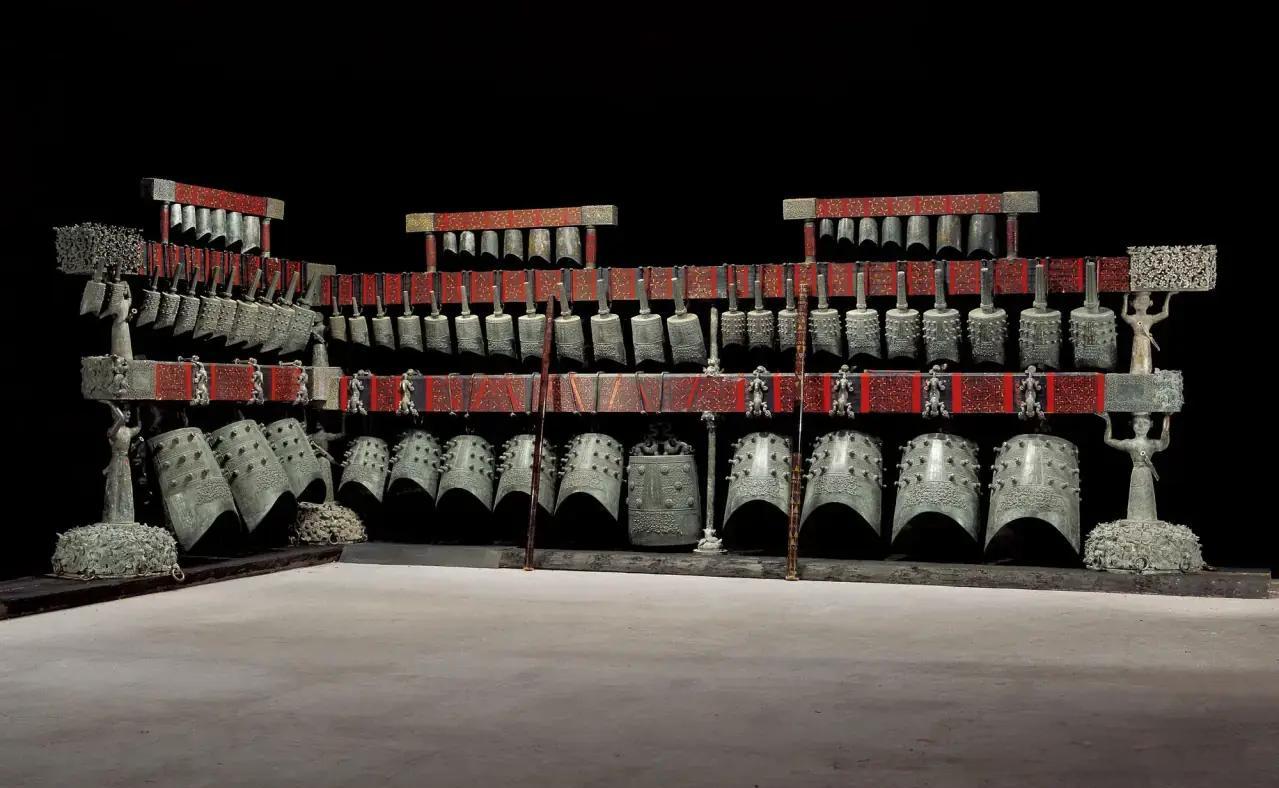曽侯儀の鐘: 古代中国の不朽の名作
アーティファクトの紹介
The 曾后儀鐘(曾侯儀のチャイムベル), とも呼ばれます 曽毅侯の鐘, これまでに発見された古代の青銅の鐘のセットとしては最大かつ最も保存状態が良い. で発掘された 1978 隋州の曾の李侯の墓から出土 (以前は翠仙), 湖北省, この珍しい楽器の歴史は戦国時代初期にまで遡ります (その周り 433 紀元前). アンサンブルは以下で構成されています65 青銅の鐘, に配置されています3つの層と8つのグループにL字型の木製と銅製の鐘ラック測定する7.48 メーター (24.5 足) 長さ, 3.35 メーター (11 足) 広い, そして 2.73 メーター (8.96 足) 高い. セット全体の重さは驚くべきものです2,567 キログラム (5,657 ポンド), 最も大きな鐘が立っている1.52 メーター (5 足) 背が高くて体重が重い 203.6 キログラム (449 ポンド), 一方、最小のものはちょうど20.4 センチメートル (8 インチ) 高くて 2.4 キログラム (5.3 ポンド). などの高度な技術を使用して作られています。鋳造, 溶接, 象嵌, そしてゴールドの装飾, 鐘は青銅冶金の傑作であるだけでなく、複雑な細工が施されています。彫刻, 彫刻, そして漆絵.
関数 & 使用
もともとのために作成されました儀式音楽, 宮廷儀式, そして王室のエンターテイメント, 曽侯儀の鐘は権力と文化の洗練の象徴でした. でプレイできますアンサンブル, 生産する幅広い音色—深く共鳴する低音から (下の鐘を木槌で叩く) クリアする, メロディックな高音 (上部の鐘に竹製のストライカーを付けて演奏します。). 著しく, 各ベルは 2 つの異なるピッチを生成できます (長三度または短三度離れている) 叩かれる場所によっては, を可能にするフルクロマチックスケールの 12 半音, でのパフォーマンスを可能にするペンタトニック, 六張, あるいは七音音階さえも. これ “1つの鐘, ツートーン” (1つの鐘が2つの音) テクノロジーは隋の後に失われた (581西暦 –618 年)この発見でのみ再発見されました, 古代中国の音楽理論に対する私たちの理解に革命をもたらす.
歴史的背景
鐘は鳴る金文の碑文, 所有者の名前も含めて, 曽の易侯, そして31-最大の鐘の文字碑文 (後に楚王が追加したもの) での彼の死を記念して433 紀元前. これらの碑文は次のことを提供します貴重な歴史的記録の周王朝の祭祀音楽体系 (儀式と音楽システム)と楚国間の音楽交流, ジン, そしてチー. お墓そのもの, の一部レイグダン (レイグダン) 埋葬施設, で偶然発見されました1977建設工事中に発掘された1978, 他にもたくさんの宝物を明らかにする, 含む漆器, 兵器, そして完全なオーケストラのセットアップ.
保存 & 文化的意義
今日, Zenghouyi Bells は湖北省博物館武漢で, 彼らはその一部であり続けます最も貴重な工芸品. として認識されています中国の国宝, 彼らは上に置かれました海外での展示が禁止されている工芸品の最初のリスト (2002)彼らの保護を確実にするために. で2025, に刻まれていました。ユネスコ世界記憶遺産登録, 彼らを青銅の鐘に刻まれた世界最古の音楽写本. 彼らの発見音楽の歴史を書き換えた, それを証明する中国では、12 音平均律が完全に発達していました。 2,000 西洋より何年も前に.
価値 & 遺産
曽侯儀の鐘は単なる楽器ではなく、古代中国文明の輝きの証です。. 彼らは展示します:
✔高度な青銅鋳造技術 (合金比率の精度, 個性的 “複合ベル” デザイン).
✔洗練された音楽理論 (チューニング システムに関する既知の最古の文書).
✔文化外交 (外交上の贈り物として楚時代の鐘が含まれる).
✔エンジニアリングの驚異 (ベルラック, 青銅の戦士像に支えられている, 二千年以上続いている).
温かい招待状
訪れることがあれば武漢, 中国, への旅湖北省博物館曾后威鐘を見るには必見です. これらの前に立つ2,400-歳の鐘, 古代のメロディーのエコーを聞くだけでなく、中国青銅器時代の職人技と音楽の天才の頂点. Marquis Yi の世界へようこそ。歴史, 科学, とアートが完璧に共鳴して調和します.
“これらの鐘が歌うとき, 彼らは皇帝の物語を語ります, 学者, そしてその伝統が今も脈々と受け継がれている職人たち。”
